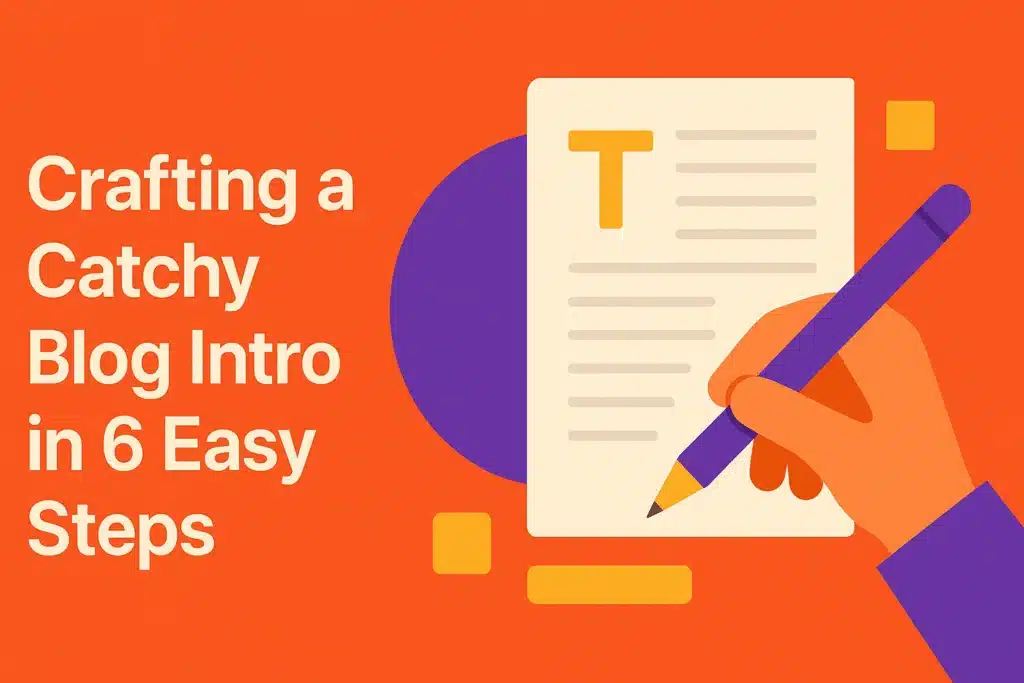Readers scan, looking for quick insights. If those initial lines fail to spark interest, potential followers vanish. That’s why a strong intro matters—like the opening paragraph of an enthralling novel, it attracts readers. By focusing on how to write a catchy blog intro that speaks directly to your audience, you create an immediate connection and promise real value.
Why a catchy blog intro makes a difference
Readers decide in seconds whether your blog introduction holds value. A catchy opener can set the tone, build interest, and encourage clicks. It also affects search performance, as engaging content lowers bounce rates. Without a strong start, potential visitors often leave before your main points can shine. Make it count!
How a blog introduction shapes reader behavior
Your blog introduction influences. It affects bounce rates, time on page, and the chance that someone will continue reading. Short paragraphs and concise sentences keep readers engaged, since those exceeding 25 words often cause quick exits. Each moment counts when 4,800 new posts go live every minute [BrandWell]. A strategic opener signals relevance and encourages visitors to remain. By showing empathy, offering value, or highlighting a pain point, you guide readers closer to your core message.
Examples of low vs. high-performing blog openings
Consider a dull intro that boasts about a product without addressing reader needs. That style prompts a quick exit. In contrast, a strong opener teases the content without giving everything away, earning trust. Studies suggest readers vanish if the intro bores them within thirty-seven seconds ([LeanLabs](https://www.leanlabs.com/blog/blog-introduction-examples-good-bad)). High-performing examples ask a bold question, offer a mystery, or highlight a surprising fact. This difference can transform a simple click into a meaningful read. Low-performing intros lack that crucial spark.
6 steps to nail your blog introduction
These steps clarify how to begin a blog post well. Each move targets interest, empathy, or direct benefits. By following them, you build a solid structure that pulls readers in and creates real interest. Consistency across every step ensures an engaging blog opening that positions your points for maximum impact.
Hook your readers with interest-driven lines
Interest hooks can pull readers in away. You might open with an unexpected fact or a surprising twist that challenges everyday assumptions. For instance, a weird statistic or an unusual statement sets the stage for a deeper reveal. Readers value a prompt that grabs their attention without spoiling anything early. According to research, a promise in the opening line boosts attention because people want that payoff [Ideawrights]. Always deliver on what you initially promise. Interest increases engagement.
State a bold benefit to spark interest early
A bold benefit in your opener assures readers they’re investing time wisely. For example, claim you’ll show them a strategy that double their social shares. That quick perk creates more interest. There are 600+ million blogs where readers might land, so you must stand out ([CoSchedule](https://coschedule.com/blog/11-tips-best-practices-writing-blog-post-introduction)). When you state a clear benefit, respect that promise and fulfill it. This step builds trust and positions your post as a key resource. Early clarity is essential for audience commitment.
Use a relatable question to connect quickly
Posing a direct question at the start forms an instant link with readers. About 73% of people skim blog posts, so a well-placed query prompts deeper reading [Outranking]. Ask something that highlights a common problem or common goal, such as “Do you struggle to find new content ideas?” That nudge generates interest and creates a connection. Keep it specific to the topic, and promise an answer in your main points. Readers value a fast, friendly approach.
Mention the pain point or problem up front
Naming your audience’s problem early shows you understand their struggle. If 80% of visitors never move beyond headlines, you must quickly highlight the issue to keep them reading [Rob Powell Biz Blog]. Show that you have a solution but save the full details for later. This teaser builds excitement and prompts them to go further. When readers see their challenges recognized, they stick around, ready to discover how you’ll address those concerns. Direct honesty encourages deeper trust.
Preview what the reader will learn in the post
Offering an overview of key takeaways keeps readers interested. Show them the main points: tips, strategies, or answers they’ll find in your blog introduction. Many blog users skim, so a concise preview helps them gauge worth [Outranking]. Bullet or numbered lists simplify what follows. Clarify each section’s focus without revealing every detail. This approach gives structure and promises relevant content. By providing a simple overview, you keep visitors from drifting away in search of clearer guidance today.
Use telling stories to bring the blog intro to life
Stories capture interest by letting readers see themselves in the situation. For instance, describe a short anecdote that mirrors their challenge—like missing a big deadline—and tease how your post helps fix it. Users often spend around 52 seconds skimming, so an easy to connect with narrative stands out [CoSchedule]. Avoid dragging on too long. Keep it concise, tie it back to your main topic, and promise a meaningful solution soon. Such telling stories creates understanding. That emotional connection encourages readers to continue.
Pro tips for writing a good blog intro
Pro suggestions focus on refining every detail of your opening. They help you gauge engagement, spot pitfalls, and craft a clear message. By testing reactions and avoiding common errors, you boost clarity and trust. Follow these pointers steadily, and your writing a good blog intro strategy becomes much more persuasive.
How to test your intro for engagement
Check bounce rates and average time on page to see if your intro works. If people still exit in seconds, they lost interest quickly. You could run A/B tests with two different introductions to measure which one retains more viewers. Surveys or direct feedback also reveal if your content connects with readers. Keeping the introduction under 200 words aligns with best practices ([CoSchedule](https://coschedule.com/blog/11-tips-best-practices-writing-blog-post-introduction)). If engagement rises, your opener likely hits the mark. Test small changes, such as removing fluff.
Avoiding common blog opening mistakes
Overloading your first paragraph with excessive data confuses readers. Research shows the average user spends only 54 seconds on a webpage [ClearVoice]. A massive text block or unrelated details may cause them to bounce. Another slip is ignoring a clear thesis: if readers can’t see how your post helps, they leave. Also, a boastful tone harms trust. Keep the intro focused, engaging, and user-centered so people know they’ve come to the right place. Brief clarity wins retention.
Conclusion
Crafting an opening paragraph that connects with readers increases reader loyalty. When you highlight a problem, offer a potential fix, and show clear benefits, you build instant trust. Strong hooks, questions, and telling stories keep visitors on the page. Interest and empathy matter just as much as facts or stats. Each tip, from stating a bold benefit to previewing key takeaways, offers a practical method for polishing your blog introduction. By avoiding pitfalls, testing engagement, and appealing to your audience from the start, you create a welcoming setup. The result is a post that holds attention and drives action.
FAQs
What is the best length for a blog introduction?
How to write a catchy blog intro for SEO purposes?
Can I ask a question in the opening of my blog?
What’s an example of a great blog introduction?
Is starting a blog entry example helpful when coming up with ideas?
Does an engaging blog opening impact time on page?

Ridam Khare is an SEO strategist with 7+ years of experience specializing in AI-driven content creation. He helps businesses scale high-quality blogs that rank, engage, and convert.



